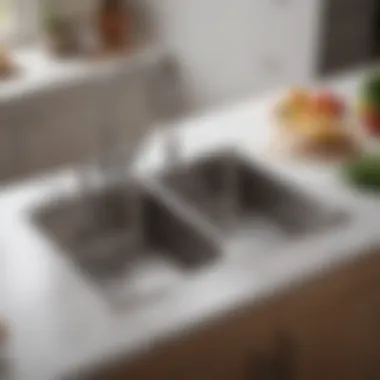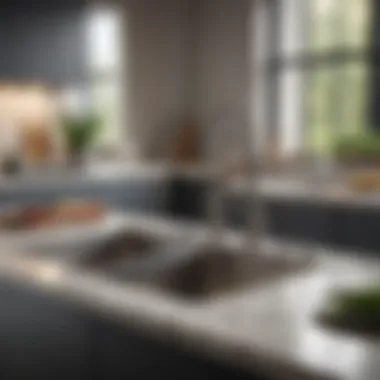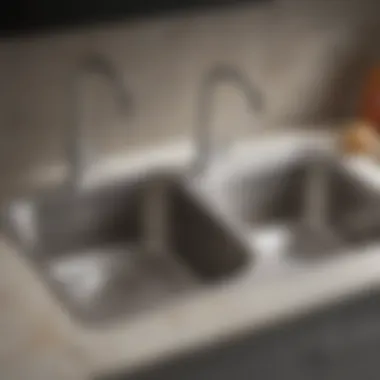Enhancing Functionality with a Two-Faucet Kitchen Sink


Intro
In contemporary kitchens, the design and functionality of a two-faucet kitchen sink serves as a pivotal aspect often overlooked in culinary planning. It combines practicality with aesthetic appeal, making it evident why the two-faucet model is becoming increasingly favored by busy homes. The unique configuration facilitates efficient multitasking, especially valuable when cooking and cleaning simultaneously.
This article explores the multifaceted advantages of incorporating a two-faucet kitchen sink, elaborating on its design integrity, functional versatility, and ease of integration into existing kitchen layouts. With this detailed guide, it aims to assist discerning homeowners and culinary enthusiasts who seek to enhance their kitchen's efficiency without forgoing style.
The key features discussed will include the various styles and materials of two-faucet sinks available, their unique benefits for a wide array of culinary tasks, and critical aspects regarding installation and maintenance. By delving into these considerations, readers will better appreciate how a two-faucet sink contributes to both culinary accomplishment and kitchen beauty.
Preface to Two-Faucet Kitchen Sinks
The choice of kitchen sink significantly affects both the functionality and style of the kitchen space. Two-faucet kitchen sinks, in particular, offer several advatnages. They serve essential roles in food preparation and cleanup, making them ideal for families or homes where cooking is a central activity. In the hectic pace of modern life, the efficiency of these sinks comes to the forefront. For those who enjoy culinary pursuits, understanding their purpose and proper integration is imperative.
Definition and Purpose
A two-faucet kitchen sink features separate faucets for hot and cold water. This differentiation can improve both comfort and efficiency. Each faucet can be tailored for specific tasks, streamline the workflow, and optimize daytime water usages.
Possessing two distinct water sources can support various tasks. For instance, one faucet can be used for washing dishes with hot water, enhancing the sanitary cleaning experience. Meanwhile, the other accommodates rinsing vegetables or filling pots with cold water quickly. This division allows for increased versatility, essential for multitasking in the kitchen.
Historical Context
The origins of the two-faucet sink can be traced back to earlier plumbing developments. Initially, kitchens relied on basic hand pumps or single slabs for water. Evolving plumbing technologies allowed for the introduction of distinct hot and cold water supply. This transformation not only provided users with comfort but revolutionized kitchen task management.
Over the decades, different designs have emerged. Early sinks featured simple ceramic materials, suggesting utility over appearance. However, manufacturing advancements saw the production of elegant stainless-steel sinks, which marry both function and aesthetic appeal.
The trajectory of the two-faucet kitchen sink highlights a trend towards increased sophistication and improved functionality over the years. As home cooks evolved in their craft, so did the tools they used, laying the foundation for today’s comfortable and diverse kitchen environments.
Advantages of Two-Faucet Sinks
The choice of a two-faucet sink offers numerous advantages for both functionality and aesthetics in the kitchen. Understanding these benefits can guide potential buyers to make informed decisions. A two-faucet sink can change the kitchen experience by providing unique solutions to common challenges faced in culinary tasks. This section will explore key benefits such as and improved workflow, enhanced water management, and design flexibility.
Improved Workflow
A well-designed kitchen supports the efficiency of cooking processes. Two-faucet sinks facilitate multitasking, especially helpful in busy households. The separation of warm and cold water provides easy access to different water temperatures without delay, streamlining various tasks like washing vegetables or rinsing dishes.
With a two-faucet sink, prep work becomes quicker and more organized. Having a dedicated side for splashing and wasting little water is vital when you're in a rush. Cooks could potentially overlap their tasks, thus minimizing time spent in the kitchen: if someone's kayshing dishes on one side, another user can wash fresh produce on the other.
By optimizing workflow, the two-faucet sink contributes to a more enjoyable cooking experience.
Enhanced Water Management
Water usage is an essential consideration in kitchen design. Two-faucet kitchen sinks can significantly enhance water management capabilities. As homeowners look towards eco-friendly solutions, efficient fixtures are becoming more popular. Two faucets enable users to manage water flow based on need, reducing excess usage.
For example, if one faucets predominate hot water and the other cold, users have firm control over temperature and pressure. This added control permits cooks to choose the ideal conditions for specific tasks, achieving better results in daily chores.
Additionally, the separation can assist in avoiding cross-contamination in preparation tasks, heightening focus on health and safety.
Design Flexibility
Design plays a crucial role in any kitchen. Modern styles often dictate sleek lines, intricate customization, and integrating essential elements smoothly. A two-faucet sink offers significant design flexibility. Whether one prefers a classic or contemporary look, multiple faucet types allow for creative solutions without compromising the overall aesthetic.
The two-faucet system can easily blend with various materials, such as stainless steel or ceramic, ensuring that it fits seamlessly with the broader decor of the kitchen. Moreover, users can choose finishes that match kitchen cabinetry or countertops. Beyond aesthetics, the range of faucet options allows for powerful flow and effective usage, depending on the user’s needs.
As a result, homeowners can adapt kitchen space to their preferences, ensuring that functionality aligns closely with style.
A two-faucet sink enhances the overall culinary experience through improved workflow, effective water management, and design adaptability.
Overall, two-faucet sinks provide thoughtful, practical solutions. They cater to functionality while reinforcing style, business, and broad uses within the kitchen.
Choosing the Right Style
Choosing the right style for a two-faucet kitchen sink is crucial. It influences not only functionality but also the overall aesthetics of the kitchen. A well-selected sink enhances the cooking experience and aligns with the home’s design theme.


Modern vs.
Traditional
Modern kitchen designs often emphasize sleek lines and minimalist features. A two-faucet sink can blend seamlessly into such environments. With clean edges and integrated features, modern styles focus on efficiency. They may include touchless faucets or built-in water filtration systems.
In contrast, traditional styles are timeless. They often feature decorative elements and can include elegant ceramic fixtures. Choices are available for ornate designs that stand out as a focal point in the kitchen. Blending traditional aesthetics with modern efficiency can result in a unique design.
Materials Consideration
The material of a two-faucet sink plays a significant role in its functionality and appearance. Below, the considerations regarding stainless steel, ceramic, and composite are discussed in more detail.
Stainless Steel
Stainless steel is highly durable and resistant to stains and rust. This contributes greatly to its popularity among kitchen sinks. One of the key characteristics is its neutrality which allows it to match almost any kitchen style.
A unique feature of stainless steel is its approach to heat resistance; it withstands high temperatures well. Furthermore, it does not absorb odors, making it a beneficial choice for avid cooks.
However, a downside can be the scratching that might occur over time. Regular maintenance is needed to keep it looking polished and new. Despite this, its practicality and sleek look make it a favorite choice among many.
Ceramic
Ceramic sinks offer a rich, traditional feel. They are often glazed to ensure both beauty and function. A notable characteristic is their aesthetic appeal, giving a classic touch to the kitchen.
Ceramic’s surface is glossy, so it does not stain easily and can know hold on to odors. A unique feature is that ceramic can be molded into various shapes and designs, thus showing numerous styles.
That said, one should be cautious of their susceptibility to chipping. Heavy pots or rough handling may create cracks. Therefore, it may not be ideal for every kitchen environment, especially busy homes.
Composite
Composite kitchen sinks, made from a blend of materials, use advanced technology. They offer a vast color selection and design possibilities. A key characteristic is their resilience; they resist scratching and are generally long lasting.
They do not require much maintenance. The color saturates throughout the material rather than just on the surface. This uniqueness provides an appealing aesthetic that can complement modern and traditional kitchens alike.
On the flip side, composite sinks may be more costly. The installation can also demand more skill compared to other materials. Nonetheless, they provide ample versatility and can elevate the overall look of the kitchen.
Considering these materials carefully allows for informed choices that enhance functionality and match personal design preferences.
Installation Considerations
The installation of a two-faucet kitchen sink involves several critical factors that can enhance both functionality and visual appeal in kitchen spaces. Proper consideration during this phase is essential for maximizing benefits. An inadequate installation can lead to problems that affect convenience and durability. Here, we will discuss the significance of careful planning, plumbing requirements, and the decision between hiring a professional versus undertaking the project yourself.
Planning the Layout
When planning the layout of a two-faucet sink, several details must be taken into account. Accessibility is paramount; ensure that both faucets can be reached comfortably while cooking or cleaning. Space is another consideration. The sink needs to be positioned to allow ample movement around work surfaces and appliance options.
While designing the layout, consider the sink's dimensions. A larger sink may require additional countertop space and cabinet support. Also factor in pots and pans sizes, to ensure adequate depth and width for washing them effortlessly.
Important points to consider when mapping out layout includes:
- Positioning: Ensure that both faucet handles are conveniently located.
- Countertop space: Avoid clutter by considering surface areas around the sink for drying dishes or preparing food.
- Integration with kitchen workflow: The sink should belong to the natural flow of cooking and cleaning tasks.
Plumbing Requirements
Plumbing is an essential aspect of installing a two-faucet kitchen sink. Ensuring that the existing plumbing is compatible with the planned sink arrangement can prevent future complications. The correct faucet fittings and water supply connections are needed for both sides of the sink to operate properly.
Elements to be aware of include:
- Water lines for both hot and cold water, appropriately connected to each faucet.
- Drainage compatibility: Verify that the sink's drainage system aligns with the established plumbing to avoid leaks.
- Pressure balance: Managing the water pressure adequately to prevent inconsistent flow is necessary. Ensure additional pressure regulators if needed.
When conducting plumbing installations, local regulations influence what can be done. Checking codes and typically requiring permits before starting is wise.
Hiring a Professional vs.


DIY
The choice between hiring a professional and doing it yourself (DIY) needs careful thought. Each option has unique advantages, and the best path will depend upon skill level, budget, and time constraints.
Hiring a Professional
Choosing to hire a professional can impart peace of mind. Skilled plumbers often bring expertise and familiarity with typical complications found during installation. Their knowledge generally leads to a clean, efficiently installed sink with fewer chances of interface issues.
DIY Installation
On the other hand, attempting a DIY approach could save costs but may call for a high level of commitment. If individuals possess prior plumbing experience and handy skills, this route could be rewarding. Proficiency ensures that no major issues will arise during installation.
Ultimately, the decision depends closely on confidence in one’s abilities and time available. Opt for the method that aligns best with your objectives and ensures a functioning, long-lasting unit.
Remember: Even a seemingly minor error in plumbing or layout can cascade into larger problems, affecting functionality and possibly incurring additional costs long-term.
Maintenance of Two-Faucet Sinks
Maintaining a two-faucet sink is an essential component of its overall functionality and longevity. Understanding how to properly care for this unique kitchen fixture greatly enhances its usability. Neglecting maintenance can lead to various problems that may affect kitchen performance and aesthetics. Routine care and addressing common issues keep the kitchen space operational and visually appealing.
Routine Cleaning Tips
Routine cleaning is vital for keeping your two-faucet sink looking and operating at its best. Here are practical tips for maintenance:
- Use Mild Soaps: Avoid harsh chemicals when cleaning. Gentle dish soap combined with warm water effectively removes daily grime and stains without damaging the sink's coating.
- Regularly Wipe Down: After use, make it a habit to wipe the sink with a soft microfiber cloth. This action prevents water spots and build-up of residues.
- Check the Faucets: Examine the faucets for any debris or hard water deposits. These can impede water flow and functionality. A mild vinegar solution can help dissolve calcium deposits.
- Dry after Use: Always dry the sink after washing dishes. Leaving water on the surface increases the risk of tarnishing or rusting, particularly in stainless steel designs.
- Inspect for Scratches: Regularly inspect the sink for scratches. Addressing these early can prevent further damage. Using a non-abrasive scrubber can aid in cleaning without causing harm.
Addressing Common Issues
During regular use, even the best two-faucet sinks may encounter some issues. Knowing how to address these problems can save time and money, ensuring ongoing functionality:
- Leaky Faucets: Over time, faucets may develop leaks. This could stem from worn-out washers or faulty cartridges. Identifying the source and replacing the components will prevent further water waste.
- Clogs: Stagnant water in the sink may indicate a clog. Use a friendly plumbing chemical or a simple bent hanger to remove debris from the drain. In severe cases, professional help may be required.
- Fading: Different materials can fade due to constant exposure to moisture or cleaning products. Utilizing milder cleaning agents minimizes these effects and prolongs the appearance of the sink.
Despite the care taken, issues may also arise. Remember the principle of prevention is better than a cure, invest time in following routine maintenance tips thoroughly to foster a prolonged expereience with your two-faucet sink.
In summary, thorough and routine maintenance vastly improves your kitchen experience by safeguarding against issues that could potentially disrupt culinary activities.
Cost Analysis
Cost analysis plays an essential role when evaluating the practicality of upgrading to a two-faucet kitchen sink. It provides insight into the allocation of resources for initial purchase and installation, as well as ongoing maintenance and potential savings. This section breaks down the financial considerations associated with two-faucet sinks, helping potential buyers make informed decisions.
Initial Investment
When considering a two-faucet kitchen sink, the initial investment can vary widely. Factors such as style, material, and functionality determine the base cost. For instance, high-quality stainless steel sinks may cost more than basic aluminum or plastic options. Custom-designed sinks will usually be on the higher end of the price spectrum. On average, homeowners may expect to pay between $200 and $1,200 depending on these factors.
Installation costs also need to be factored in. Engaging a professional plumber is highly recommended for this task, adding an additional expense of roughly $100 to $500, based on the complexity of the plumbing and the local labor rates. Therefore, anticipating total costs prior to purchase is crucial.
Long-term Savings
Though a two-faucet kitchen sink requires an initial layout investment, it offers several long-term savings opportunities. Its design typically enhances workflow, improving efficiency during meal preparation and dishwashing, resulting in time savings. This ultimately reflects in reduced utility bills since efficiency in water usage can lead to a decrease in water consumption.
For instance, high-efficiency faucets often come equipped with aerators that regulate water flow without sacrificing performance. Over time, homeowners might notice a substantial reduction in their water bills which can total hundreds of dollars yearly.
Moreover, the durability of materials used in two-faucet sinks contributes to long-term savings. For example, stainless steel sinks are less prone to damage than weaker materials. This means fewer repairs or replacements, leading to constancy in cost over the sink’s lifespan.
It is clear that evaluating cost goes beyond initial expenditure, signifying an investment in convenience and efficiency.
Comparing Single vs.
Two-Faucet Sinks
When choosing a kitchen sink, the type can significantly impact both usability and design. This is especially true when we compare single-faucet sinks to two-faucet ones. Knowing the distinctions between these options is vital for anyone looking to enhance their kitchen experience.


Functional Differences
A single-faucet sink usually provides one water source. On the other hand, two-faucet sinks elevate functionally by offering separate taps for hot and cold water. This separation allows for better temperature control. A user can select the exact warmth needed for specific tasks like washing delicate vegetables or preparing dishes.
Additionally, a two-faucet design promotes efficiency, especially in busy kitchens. For example, while one faucet dispenses water for rinsing or cooking, the other can be used for filling pots or washing hands. This feature minimizes downtime.
Key functional characteristics of these two types include:
- Water control: Two-faucet sinks enable precise manipulation of temperature.
- Multiple tasks: Facilitates performing different tasks without water interruption.
- Space management: Provides clear delineation of chore areas.
The choice between single and two-faucet sinks can greatly influence kitchen workflow, especially in multitasking environments.
Aesthetic Preferences
The appearance of kitchen fixtures plays a substantial role in overall kitchen design. Single-faucet sinks might present a minimalist look. They often appear sleek, fitting seamlessly into various kitchen designs.
Conversely, two-faucet sinks introduce more character. They offer an opportunity for variety in style due to the visible plumbing and hardware. Traditional kitchen designs favor two-faucet styles, while modern kitchens might embrace the simplicity of single options.
When contemplating aesthetic appeal, consider the following:
- Style alignment: Does the sink’s design match the kitchen's overall theme?
- Finish: Choices range from polished to matte, affecting light reflection and visual impact.
- Space: Two-faucet designs typically require more area, which may enhance or overcrowd the visual scene.
Selecting between these sink styles can either complement or disrupt the overall kitchen aesthetic. Proper evaluation of these subjective preferences allows potential buyers to make inclusive and informed decisions regarding their kitchen's functional design.
Eco-Friendly Options
Choosing a two-faucet kitchen sink carries implications beyond simple aesthetics and functionality. Eco-friendly options stand out as significant elements within this discussion. As environmental concerns increase globally, many homeowners seek solutions that contribute positively to the environment. A focus on eco-detailing can turn a standard kitchen into a more responsible and sustainable culinary space.
Water Conservation Features
One primary aspect of eco-friendly sinks is their focus on water conservation. Innovative designs and technologies assist in reducing water consumption without compromising on performance. For instance, some faucets can provide a total or partial flow rate reduction. This feature allows the user to choose an optimal flow level according to the task at hand. Both modern engineered aerators and water-saving cartridges frequently play a role in facilitating this reduction.
Advantages include:
- Decreased water bills: With less water used, the monthly costs naturally decrease.
- Conservation of essential resource: Every drop saved is a step towards preserving a vital resource right now.
- Enhanced kitchen performance: Many innovations not only save water but ^also enhance functionality, allowing for greater flexibility in cooking or cleaning tasks.
Homeowners should consider such models if they want to align their choices with environment-friendly values.
Sustainable Materials
Sustainable materials in two-faucet kitchen sinks create another layer of eco-friendliness. Selecting sinks constructed from materials like recycled stainless steel, bamboo or other responsibly sourced composites contributes significantly to reducing environmental impact. These materials are generally favored for being durable, long-lasting, and requiring less energy to produce than traditional sink material.
Benefits of opting for sustainable materials include:
- Lower environmental impact during manufacturing: Using recycled materials minimizes waste and limits resource extraction.
- Longevity: Often, sustainable materials withstand wear and tear better than conventional options, leading to fewer replacements and waste over time.
- Aesthetic appeal: Many sustainable materials often feature unique finishes that may enhance the overall dish’s design.
Homeowners and kitchen designers intrigued by a harmonized indoor space with eco-conscious substitutes may find a variety of choices that reflect their ideology.
By integrating eco-friendly options into kitchen design, not only can you maintain functionality – but every choice reflects a commitment to sustainability that resonates for years to come.
Epilogue
In summary, the integration of a two-faucet kitchen sink can vraft a hallmark for efficiency and tanganle design suitable for a modern home. This necessity, commute togethering style and practical usability, jealously guards its position in kitchen functionality, affecting daily tasks like cooking and cleaning.
Final Thoughts on Two-Faucet Sinks
Two-faucet sinks are not just about increased functionalities; they ensure every culinary task feels more approachable. Homes with dedicated ketchup and rinsing eqipment benefit from designated areas for preparation and cleanup. Such differentiation allows home cooks to streamline processes, enhancing the overall kitchen experience.
Equally, this type of sink helps foster a sense of organization which can dramatically change one’s routines. By generously allowing assigned spaces, these sinks cultivate a magment caring for ingredients and utensils. Therefore, those who cook regularly may find two-faucet designs a sincere reflectsion of their needed functions and improving their cooking skills.
Recommendations for Potential Buyers
When selecting a two-faucet kitchen sink, several factors come intro play, including but not limited to:
- Material Choices: Material makes a notable impact on sink durability and aesthetics. Options like stainless steel, ceramic, and composite differ significantly in cost and longevity.
- Design Appeal: Assess if the sink blends well with your existing kitchen decor. Matching colors and styles promotes a harmonious look.
- Size and Configuration: Ensure the selectec sink fits well within your kitchen layout. Measurement checks can prevent post-installation quandary.
- Budget: Finalise financial plans that account for any installation fees may help inform choices effectively.
Ultimately, a two-faucet kitchen sink can smoother your culinary workflow and accumalate remarkable visual appeal. Such an investment marries function and design in a manner that merits serious judgement for both practical use and visual harmony.
By taking heed to these aspects, you prepare yourself for a well-informed decision that treasure both delight and eficiency in your kitchen space.







